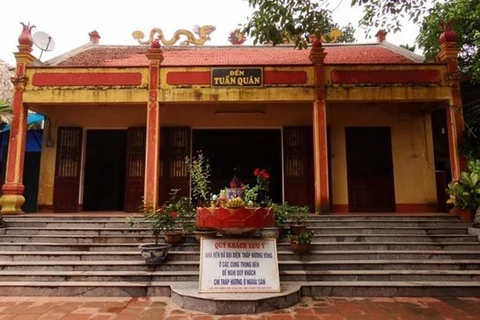Da Nang (VNA) – In the late 19th century, a French envoy named Charles Lemire discovered a relatively large number of antiquities of Cham people during his archaeological surveys and then brought them to the area which is now the central city of Da Nang to display.
After that, the French School of the Far East conducted more excavations on a larger scale and found many more items, leading to a need for a museum to exhibit these antiquities.
In 1902, Henri Parmentier, a famous archaeologist from the French School of the Far East, proposed a design plan for a Cham museum in Da Nang. Basing on this, the construction of the Museum of Cham Sculpture started in 1915 and completed in 1919.
Located on a mound on the Han River’s western bank, near the western end of today’s Rong (Dragon) Bridge, the museum's design is the combination of the European classical architectural style and that of Cham people.
The museum initially exhibited 160 Cham sculptures uncovered by Henri Parmentier in the 19th century. Since then, the collection has been added with more objects from different sources.
Given this, the Museum of Cham Sculpture in Da Nang is one of the oldest of its kind in Vietnam, even older than the Hanoi-based Vietnam National Museum of History, which was previously named the Louis Finot Museum built by France in 1926.
The first building of the Museum of Cham Sculpture was designed by two French architects, Delaval and Auclair, basing on Parmentier’s suggestion about using some architectural features of Cham people.
Undergoing many times of expansion, the museum still has its old but charming architecture kept intact and boasts highly unique exhibition spaces.
With over 100 years of conserving and bringing into play cultural values, the Museum of Cham Sculpture is considered a unique place showcasing the quintessence of Cham people’s art of sculpture, which is a precious heritage of Da Nang city as well as Vietnam as a whole.
It is currently home to about 2,000 objects, nearly 300 of which are being displayed in several sections with different topics.
The exhibits clearly reflect the cultural and spiritual life, as well as the architectural and sculptural mindset, of Cham people in the past. They also include some items relevant to the Hinduism and several others with daily life-related themes.
Coming to the museum, visitors will have a chance to admire original Cham sculptures dating back centuries ago and learn about the culture of the ancient Champa Kingdom in Vietnam’s history.
The Tra Kieu collection is among outstanding ones preserved there. Most of its items date back to the 10th - 11th century, some even in the 5th - 6th century.
Notably, they include three national treasures, namely the Tra Kieu altar, the My Son E1 altar, and the statue of Tara.
The Tra Kieu altar, created in the 10th century, is hailed as a sculptural masterpiece featuring images of 11 Apsara dancers in graceful and charming postures. It is also typical for the confluence of Indian and Southeast Asian culture.
Meanwhile, the My Son E1 altar, originated in the 7th - 8th century, vividly and artistically depicts spiritual dances of Hinduism.
The Statue of Tara, dating back to the 9th - 10th century, represents the avatar of Avalokitesvara, a Buddhist bodhisattva, in the name of Tara. It is noteworthy that this is the only bronze object kept at the Museum of Cham Sculpture./.

























